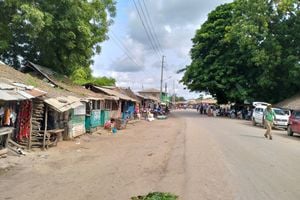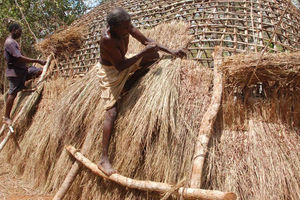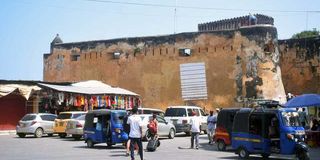
Tourists at Fort Jesus in Old Town Mombasa on December 6, 2024. Visitors avoid chaotic streets.
Mombasa, Kenya’s coastal jewel known for its rich Swahili heritage and iconic architecture, is undergoing change.
As high-rise buildings proliferate and modern urban planning takes hold, some residents and leaders fear the city could be losing its cultural identity.
Mr Ishpal Oberoi, former chairman of the Kenya Association of Tour Operators, paints a bleak picture of Mombasa.
“The coastal city was beautiful in the 1950s to 1980s,” he says, attributing the current situation to unplanned development and population growth following the influx of refugees from neighbouring countries in the 1990s.
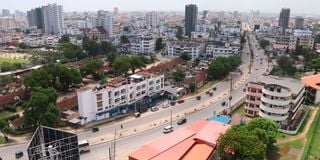
New commercial and residential highrise buildings tower over old houses in Tonnoka area of Mombasa County.
“The town is in a shambles. What people are calling a skyline is a joke with zero planning. There are no open spaces and no possibility for emergency service access after the third floor,” says Mr Ishpal, adding that Mombasa is no longer the tourist attraction it used to be.
“Visitors avoid beggar-filled and chaotic streets. They stick to Fort Jesus or Old Town. Unfortunately, even these areas lack sufficient protection for their heritage.”
According to Mr Ishpal, attractive cultural spaces like The Little Theatre Club are a pale shadow of their former self.
Dr Kalandar Khan, a senior lecturer at the Technical University of Mombasa and former Coastal Research Unit Coordinator at the National Museums of Kenya (NMK), highlights the incompatibility of modern construction materials with Mombasa’s past architecture.
“Traditional coral and lime materials had a cooling effect and preserved the character of buildings. Modern materials like steel and cement necessitate air conditioning and erode the identity of the city,” he says.
The Old Town, a UNESCO heritage site, faces pressure from developers who are eager to have historic buildings torn down.
Dr Khan cites the demolition of the Oceanic Hotel and other iconic sites as an example of modernity dismantling the cultural legacy of Mombasa.
“While high-rise buildings greatly contribute to economic growth and urban expansion, they destroy the heritage of our city. Conservation does not hinder development. Development has to be controlled. We must find ways of maintaining the history of a place while allowing it to grow,” Dr Khan says.
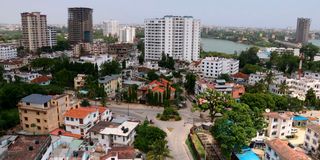
Highrise buildings in Tudor area of Mombasa County.
Fort Jesus curator, Fatma Twahir, echoes these concerns, saying modern buildings and other infrastructure distort the symbolic identity of Mombasa.
“Modernising a town prioritises strength and convenience, introducing steel and concrete at the expense of architectural harmony. Requirements have changed and so has their reflection in our spaces,” she says.
Ms Twahir adds that while cosmopolitanism has fostered cultural integration, it has also led to the demolition of old structures in favour of high-rises.
“The two types of architecture do not conform. We are losing what makes Mombasa unique,” she says.
Haki Yetu Organisation Land and Urban Development Programme Officer, Munira Ali, says the rate at which high-rise structures have taken over Majengo, Tudor and Kizingo estates is worrying.
“Born and brought up in Mombasa’s Swahili housing, I have witnessed the loss of traditional houses to developers in the name of modernity,” Ms Ali says.
She adds that traditional Swahili houses guaranteed of spacious rooms and had good lighting and ventilation.
“It is unfortunate to witness locals selling their heritage to would-be investors. They end up losing their lands, houses and even heritage,” she says.

Highrise buildings in Tudor area of Mombasa County.
Despite the grouses, some believe modernisation and heritage preservation can coexist.
“We cannot build houses entirely in the traditional way, but we can still develop while safeguarding history,” Dr Khan argues, pointing to Mackinnon market and Leven House as examples of redevelopment that retained the original fabric.
The university don also stresses the importance of tourism in preserving the heritage of the coastal city.
“Visitors come to Fort Jesus because of its history and architecture. If we lose these monuments, we lose our appeal,” he says.
Kenya’s Museums and Heritage Act of 2006 mandates the protection of historic sites and buildings, but implementation is hampered by chronic underfunding.
“While there is political will, the financial will is missing,” Dr Khan observes, calling for greater investment in cultural preservation.
At the moment, Mombasa is caught between the allure of modernity and the need to preserve its soul.
Without a balanced approach, the coastal city risks losing its heritage and the cultural and economic benefits that accompany it.
For many others like Mr Ishpal, Mombasa city “is not dying, it is already dead”.
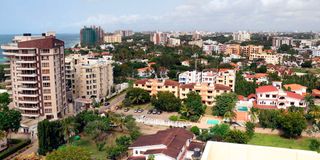
An aerial view of a section of Nyali area in Mombasa County with high-rise buildings.
Whether this becomes a prophecy or a call to action depends on how the coastal city charts its future.
In an earlier interview, Mombasa Lands, Planning and Housing Executive Mohamed Hussein rejected fears of the city losing its culture, saying there are rules that do not allow some types of houses to be built in specific areas.
“Authorities do not expect houses to be demolished and be replaced by high-rise structures in places like Old Town. The area is protected, the aim being to preserve culture,” he said.
The executive has an answer on the increasing population.
“Mombasa is growing and developers are now building apartments due to limited space, but we are doing all these within the law,” Mr Hussein said.

